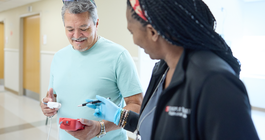
February 17, 2021
 Source/Image licensed from Ingram Image
Source/Image licensed from Ingram Image
Breast cancer death rates have increased 2.8% per year for women in their 20s and 0.3% per year for women in their 30s since 2010.
The survival rates of U.S. women with breast cancer have been improving for decades, but that is no longer the case for women in their 20s and 30s.
From 1989 to 2010, breast cancer death rates decreased between 1.5 and 3.4% per year for women in every age decade from the 20s through the 70s, new research shows.
The downward trend has continued for women 40 and older. But mortality rates have increased 2.8% per year for women in their 20s and 0.3% per year for women in their 30s since 2010.
The study, published in the journal Radiology, analyzed National Center for Health Statistics data from 1969 to 2017.
The increased mortality rates among younger women is most likely due to a spike in stage 4 breast cancer diagnoses, researchers said.
According to their data, the percentage of women ages 25-39 with metastatic breast cancer rose by 32% between 2009 and 2015. A similar trend was found among women in their 70s.
Women in their 20s and 30s being less likely to undergo regular screenings, researchers said. That allows cancers to go undetected until they are in more advanced stages.
Current breast cancer screening guidelines recommend women 45 and older get a mammogram every two years. Younger women are encouraged to have conversations with their doctors to determine the best time to start screening based on their risk factors.
"Younger women are more likely to have triple-negative breast cancers and human epidermal growth factor receptor 2-positive disease; both are more aggressive subtypes," the researchers wrote. "Younger women also are more likely to detect breast cancers themselves and therefore have disease that is at a more advanced stage at presentation than women with screening-detected tumors."
It is important for women to know their bodies well enough to spot any new changes to their breasts, Dr. Curtis Miyamoto, associate director at Fox Chase Cancer Center at Temple University Hospital, told PhillyVoice last year. He encouraged women to conduct regular self-exams to monitor any changes.
A lump in the breast or the armpit is the most common way breast cancer is detected, he said, but changes in skin texture — like a thickening, puckering or dimpling of the breast — also can be a sign of cancer.
Any asymmetry of the breasts or changes to the nipples, including discharge or peeling skin, also should be checked out, according to Yale Medicine breast oncologist Andrea Silber and radiologist Liva Andrejeva-Wright.
"Anytime a woman feels a breast mass, which does not go away, while doing a breast self-exam at any age, she should get it checked out," Silber said.
That evaluation should include both a clinical physical examination and breast imaging, Andrejeva-Wright said.
To conduct a self-exam, women should stand in front of a mirror with their arms over their head. They should look to see if their nipples are retracted, inverted (pushed inward instead of sticking out) or if there is any dimpling of the skin.
They should pay attention to any redness, soreness, rash or swelling in either breast. They also should look for any signs of discharge coming out of either nipple. It could be watery, milky, a yellow fluid or blood.
Next, women should feel their breasts while lying down. Using the pads of their fingers, they should create a circular motion as they examine the entire breast from top to bottom and side to side. Lubricating hands with lotion offers the best results.
Women shouldn't conduct a breast self-exam more than once a month and never during menstruation, oncologists say.
When detected early enough, a breast cancer diagnosis isn't an automatic death sentence. Cancer treatment process are constantly being refined, offering better outcomes.
Immunotherapy — medication that stimulates the patient's immune system to more effectively recognize and destroy cancer cells — currently is used to treat metastatic cancer. But in the next few years, it could be used to treat all breast cancer patients, Dr. Nandini Kulkarni, medical director of surgical oncology for Inspira Health, previously told PhillyVoice.
Oncologists also have a better understanding of the different genetic signatures of tumors, an advancement that has led to more individualized treatment plans for patients. Surgical techniques have improved too. That includes breast conservation, in which the surgeon only removes the tumor and some of the surrounding tissue instead of the entire breast.
As breast cancer research constantly evolves, scientists' understanding of the disease continues to grow.
The latest research from the National Comprehensive Cancer Network highlights the important of weight management after a breast cancer diagnosis. The data shows a 5% drop in weight over two years was associated with poorer outcomes among people with HER-2 positive early breast cancer. Weight gain doesn't seem to have the same adverse effect.
While the finding was surprising, the researchers couldn't differentiate between intentional and unintentional weight loss. At this point, it isn't known whether the weight loss causes the worse outcomes or vice versa. More research is needed to understand the connection.
"We hope our findings highlight the importance of incorporating consecutive and prolonged data collection on weight in oncology trials, and gaining greater understanding of the metabolic processes after cancer diagnoses that may impact outcomes," they wrote.
The bottom line? Don't ignore any concerning symptoms at any age and schedule regular gynecology checkups.